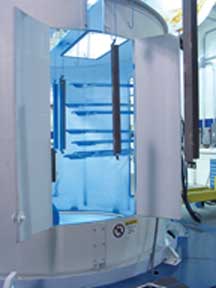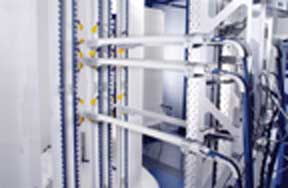
There are times in the life cycle of all businesses when tough decisions have to be made. Sometimes, though, those tough decisions are made easier by circumstance: customers wanting a better quality product, more stringent government regulations, a desire to create a better environment for employees. You simply do what you have to do.
Borroughs Corp. (Kalamazoo, MI) switched from waterborne and solventborne paints to powder to coat its line of shelving and storage products. (Photo courtesy of Borroughs Corp.)
These three factors came together a couple of years ago for the Borroughs Corp. (Kalamazoo, MI), a manufacturer of steel shelving and storage products for the health care, retail, warehousing and automotive markets. Environmental regulations prompted the company to switch from the exclusive use of solventborne coatings to a mixture of solventborne and waterborne coatings. But customer feedback and the desire to provide a higher quality finish led the company to switch completely to powder coatings. The transition was completed in about six months.
The cost to dispose of solventborne coatings was one factor in the decision. But "competition and quality were the two main reasons we switched," says Bill Virgo, Borroughs' director of marketing. "Virtually everyone else in this industry has been powder coating, and we felt like we were at a competitive disadvantage not to do it. And it's a better process, it's a better finish and it's more durable."

A big step
Converting all four of Borroughs' lines from liquid paints to powder was a big step. Virgo says it took about a year from the time the company decided to convert to the time the transition actually began.The process got underway in earnest with the conversion of the first line during the Christmas break in 2001. The final two lines began production in July 2002.
"We converted two high-solids paint lines and two waterborne dip lines," says Dan Mehren, Borroughs' manager of manufacturing engineering. "We changed one at a time, shifting the production demand to another paint line. Each line needed new HVAC units, desiccant dryers and other miscellaneous items necessary for powder coating.
Among those miscellaneous items, of course, is a booth in which to apply the powder and new spray guns. For these, Borroughs got in touch with Nordson Corp. (Westlake, OH).
Since part of Borroughs' claim to fame is its proficiency with smaller jobs and custom work, a system that facilitated quick color changes for the couple of dozen colors the company uses was a must. Borroughs was able to provide custom colors in liquid because of its in-house mini-tint system, which uses a color computer to generate formulations. The company had to decide whether to maintain this aspect of its business or let it go since small batches in custom colors can be tricky to do with powder.
The first step in addressing this issue was to choose the Nordson Sure Clean powder spray booths for its changeover. The high-efficiency Sure Clean booths allow the company to change colors in 10 to 15 minutes, Mehren says.
"The Sure Clean system has a floor that rotates at 30 fpm," says John Binder, Nordson's marketing manager. "It helps take powder out of the system and minimize powder in process. It's not a self-cleaning booth."
"The rotating floor is a big advantage," Binder says. "There's a duct that's suspended just above it that extends about half way across the diameter of the booth. The duct collects the powder from the floor and sends it to the cyclone where the large particles are separated and transferred from the base of the cyclone to the feed center. That powder is then sieved and dropped back into the original feeder or box."
The reason the Sure Clean system is capable of such quick color changes, Binder says, is its composite canopy, which resists powder attraction. "In combination with the rotating floor, there's very little powder in the process. That means there's less powder to clean, which makes color changes faster."
In addition to the composite canopy and rotating floor, the booth also uses a cyclone recovery system, blow-off nozzles at the gun slots and a feed center to speed up the color-change process. The doors are closed during cleaning so that no powder can be blown out of the booth during interior cleaning.
Prior to buying the equipment, Borroughs personnel made several trips to Nordson's testing facilities in Cleveland, where they ran a variety of parts through both their automatic and manual booths, Mehren says. "And we did some testing in-house with the handguns prior to installing the equipment."
Borroughs now has two automatic and two manual lines. The two manual booths shuttle products at about 18 and 22 fpm and have four handguns. The faster line has smaller parts with less-complex geometries. The slower line has more difficult parts to paint, many of which are up to 108 inches long. "That's a significant amount of steel coming through the booth," Mehren says.
Of the two automatic lines, one runs at 30 to 32 fpm; the other, 15 to 22 fpm. Again, the faster line runs parts that are easy to hang and remove. The slower line has more parts to hang, and they're slightly more difficult to paint.
Borroughs' goal was to be able to cure all parts for at least 15 minutes at 350 to 360°F. If it couldn't, Borroughs may have needed to use different types of powder coatings. Fortunately, everything cures properly with the same powder. "We shoot for a 60 gloss, plus or minus 5, and the colors match very well," Mehren says.

The challenges
The two manual lines were installed without a hitch and production went smoothly. The automatic lines, which replaced the two former dip lines, were a bit of a challenge. The more complex product geometry of those parts and their orientation were not issues when they were dipped. But getting the parts completely coated with the automatic guns was more difficult."We had to develop new racking and fixtures to give us better part orientation," Mehren says. "And we had to move some of those parts to the manual line."
The company has three gas-fired cure ovens, all of which needed to be refurbished, and one of which needed to be extended to add dwell time. "At the same time, we replaced all the ductwork to get better airflow," Mehren says.
Also, parts of the factory had to be reconfigured. "We had these steel dip tanks located in a large cement pit in the back of the factory on one of the last lines we converted," Virgo says. "They were filled in and covered over, and that room was completely converted, which was a lot of work."
"The other rooms were fairly easy to convert," Mehren says. "We just tore out the liquid equipment and ducting and refurbished the rooms. The rooms were cut down in size somewhat, and insulated drop ceilings added to reduce heating costs. We also painted the walls and redid the floors-basically just to make it look pretty."
Another challenge was teaching the painters how to use the equipment and not overspray or underspray, Mehren says. "It was done on the fly and Nordson did a great job of coming in several times to help us learn how to spray. Our powder suppliers also gave us a lot of tips and provided a lot of support."
It took the painters about a week or so to become relatively proficient at their new skills. They practiced using different tips, spraying different patterns and working with the controller to get the highest transfer efficiency. "They're still learning, but they're doing real well," Mehren says.
And they're happier. "They'd much rather spray powder," he adds. "Now they're in a nice cleanroom that's temperature-controlled and they don't have to deal with the solvents and fumes."

A happy coincidence
The switch from liquid to powder coatings meant that Borroughs would probably have to leave a longtime partner behind. For more than 20 years, Borroughs had gotten its liquid coatings from Jamestown Paint Co. (Jamestown, PA)."Our liquid plant supplied them with all of their waterborne products. I think their decision was market-driven-powder coating is typical for that industry," says Rich Walton, executive vice president of the company's Jamestown Powder Coatings Inc. operation.
" "We didn't know Borroughs was considering a switch," Walton says. "Our getting into the powder industry happened about the same time, but we didn't enter it to supply them. They were in touch with a lot of powder manufacturers and, at the time, we declined to bid on the business."
"But Walton says that Borroughs' desire to maintain its small-batch, custom-color business was right up Jamestown's alley because the company's minimum order is 10 pounds. "The market perception is that you can't get custom colors quickly matched in any size batch," Walton says. "We do this."
" "They used to make their custom colors in-house and apply them almost the same day," Walton says. "Powder doesn't lend itself to that because it's very manufacturing intense. One of their biggest issues with going to powder was how they were going to continue to service the custom specialties."
" "After the first line was up and running, they told us they had a problem getting small volumes of powder for small custom specialties," Walton says. "We provided the solution. Borroughs is unique in that we're probably doing something for them every week. We also have customers that might call us once or twice a year."
"Walton says the company had been looking to manufacture powder coatings for about 10 years but couldn't justify the expense of getting into what he calls a "commodity" business.
" "As we looked at the marketplace, everyone told us there was a niche in the small custom specialties," Walton says. "Nobody was doing it and people were telling us we could charge just about anything we wanted. This is a portion of the business that's a fit for us and it probably takes some pressure off the bigger guys."
" "We can turn anything around in about a week," Walton says. "Sometimes they might have a job that will require a couple of thousand pounds and they might have to wait three weeks for it. Also, if they have a big job and they should underestimate what they need, or if they get an add-on to a job, they will come to us. That's how they use us."
‘Furniture quality'
Even with a 20-year relationship in liquid coatings under the two companies' belts, Jamestown had to prove itself on the powder side. Borroughs has stringent specifications for its office furniture lines and Jamestown had to prove not only that orders could be turned around quickly, but also that the products could meet Borroughs' increased performance specifications."We're promoting it as what's known in the industry as ‘furniture quality,' meaning a nicer finish than it was," Virgo says. "It's not that our stuff was schlocky before-we've sold into the office environment for most of our existence, so our products have to look good. But if you do a side-by-side comparison between the liquid coated or a dipped part and a powder coated part, the difference is night and day. You can see it and feel it. A lot of the feedback we've gotten from our dealers and reps has been very positive."
"Mehren says Borroughs is on track to amortize the cost of the switch in three and a half to four years. "The long-term benefits from converting from liquid to powder would be cost savings-in raw materials, environmental compliance, etc.-higher quality products and a cleaner, safer work environment," he says.



